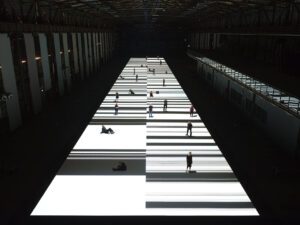This March, more than 115 of the world’s leading fine art photography galleries offer a range of museum-quality work for the 37th edition of The Photography Show presented by AIPAD (the Association of International Photography Art Dealers). AIPAD President Catherine Edelman discusses the rise of the international fair and its widespread importance.
A: The Photography Show presented by AIPAD (the Association of International Photography Art Dealers) is now in its 37th edition and has grown significantly since its inauguration. How do you think it has changed and developed over the years as a key international event?
CE: AIPAD’s fair, The Photography Show, originally started as a tabletop art fair presented in hotel conference rooms. Like The Armory Show – which started in a hotel – the fair has grown with the market, as more and more gallerists started showing photography. Twelve years ago we had the opportunity to move the fair to the Park Avenue Armory, which is the premier venue in New York City. While the Armory is a fantastic space, the limited square footage of the space defined the size of the booths. With more and more dealers showing large work, the move to Pier 94 was inevitable.
Since AIPAD’s inauguration, the photography market has exploded worldwide. And while other art fairs have entered the market, AIPAD is the only membership based photographic art fair on the scene. Our members agree to a code of ethics that states that all members agree to conduct dealings with the public, museums, artists and other dealers with honesty and integrity. Members agree to provide accurate descriptions of photographs in all disclosures, including but not limited to, invoices, wall labels and price lists. This transparency sets us apart from others fairs and has solidified us as a key international art fair.
A: Why do you think that photography fairs are important in terms of the 21st century art market?
CE: Photographic art fairs are important because they show the strength of the medium within the context of fine art. In the case of AIPAD, you can see, in one room, the history of photography from the earliest salt print to something made last month.
A: How do you think that AIPAD is pushing the boundaries of understanding of contemporary photography, providing something different to other international fairs?
CE: One of the strengths of the AIPAD membership is that we have dealers handling all areas of the photographic market. Many of the contemporary photography dealers are at the forefront of what’s happening today, showing works that push the boundaries of the traditional photographic print. Video and new media sits alongside vintage and modern works, creating a comprehensive look at the history of photography.
A: In terms of galleries that are attending this year, is their anyone in particular that people should be looking out for?
CE: I can’t single out a specific gallery or artist, but I expect everybody to bring their A game. This is a brand-new venue with an unbelievable amount of opportunity. This year’s fair will showcase what AIPAD does best: present high quality work creating an immersive, educational experience.
A: In terms of the work that is being presented, do you think there are any recurrent themes or subjects that photographers are addressing, any kind of cohesion across dealers?
CE: Among the themes and trends we’re seeing in the work that will be on view are immigration, social justice, climate change, civil rights, gender issues, African American identity, cameraless photography, abstraction, portraits, work by women photographers, and early photography.
A: Could you briefly speak about the three special programmed events, and what they’re offering to audiences in terms of important themes?
CE: We invited three collectors to show works from their collection. Each collector was given the freedom to curate his or her own booth, without limitation. Madeline Plonsker has a very thorough collection of Cuban photography from 1992 to the present, and will exhibit work by important Cuban photographers. Martin Margulies is presenting work by 20 artists from 15 countries including Afghanistan, Botswana, China, Egypt, England, Ireland, Manila, Nigeria, Peru, Poland, Russia, Turkey, and the United States. Artur Walther’s exhibition explores the ways that photographers, across a range of cultures and historical periods, have used portraiture to affirm or challenge social stereotypes constructed around notions of race, gender, class, and nationality. This selection of 507 photographs, shown for the first time in New York, establishes a dialogue between significant historical, vernacular images (daguerreotypes, American tintypes, cartes de visite from Europe and South Africa, and American mugshots) and key modern and contemporary works from Africa, Asia, Europe, and North America.
A: How do you see the future of AIPAD?
CE: I think AIPAD’s Photography Show will remain the most respected fair devoted to the art of photography.
The Photography Show, presented by AIPAD, runs 30 March until 2 April at Pier 94, New York. For more information: www.aipad.com
For the full list of galleries: www.aipadshow.com/Exhibitors
Credits:
1. Geof Kern, 10,000 Cigarettes (aka a lifetime of smoking) for a story about smoking for Esquire Magazine, Ed. of 2. (1997). Courtesy of PDNB Gallery and AIPAD.





